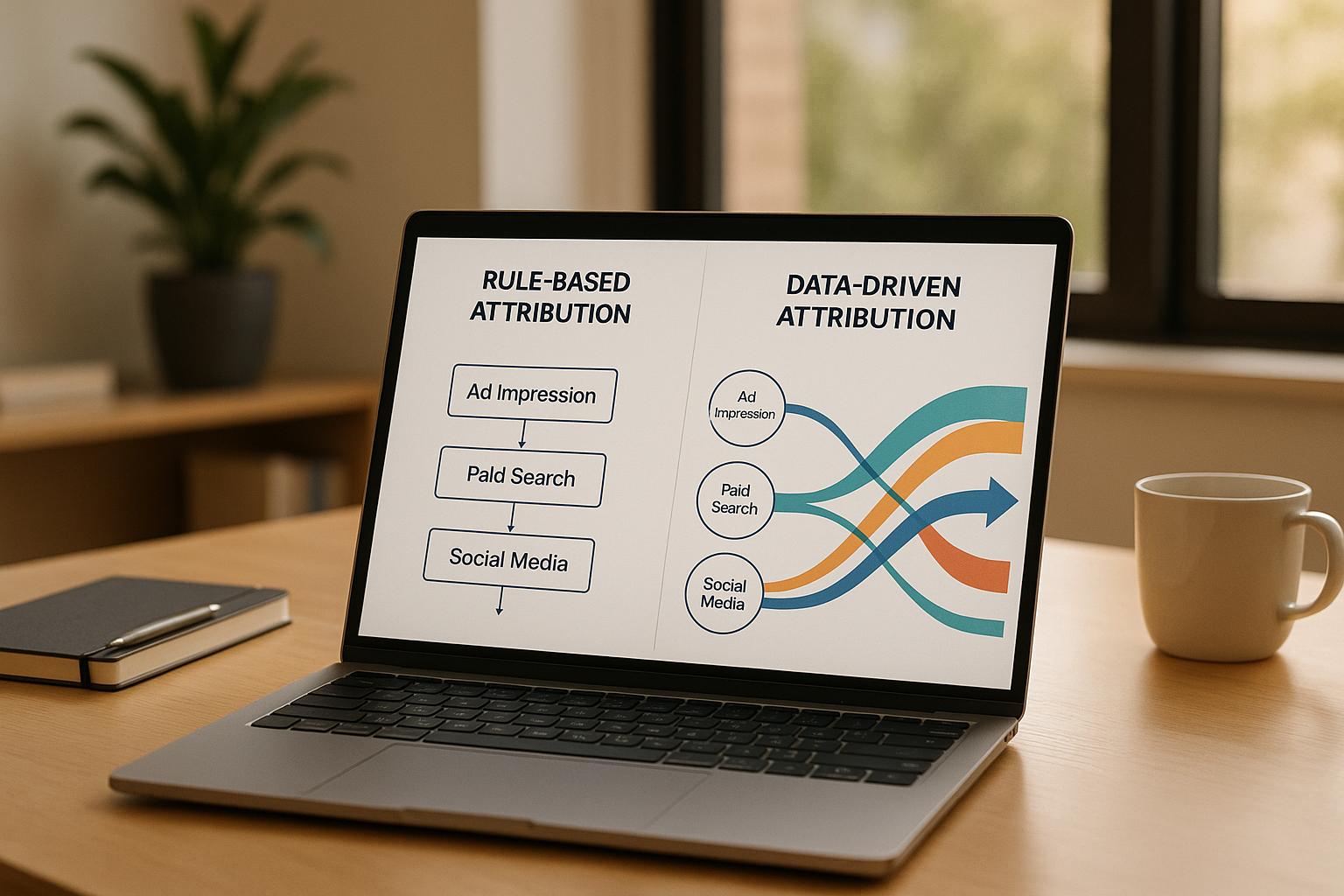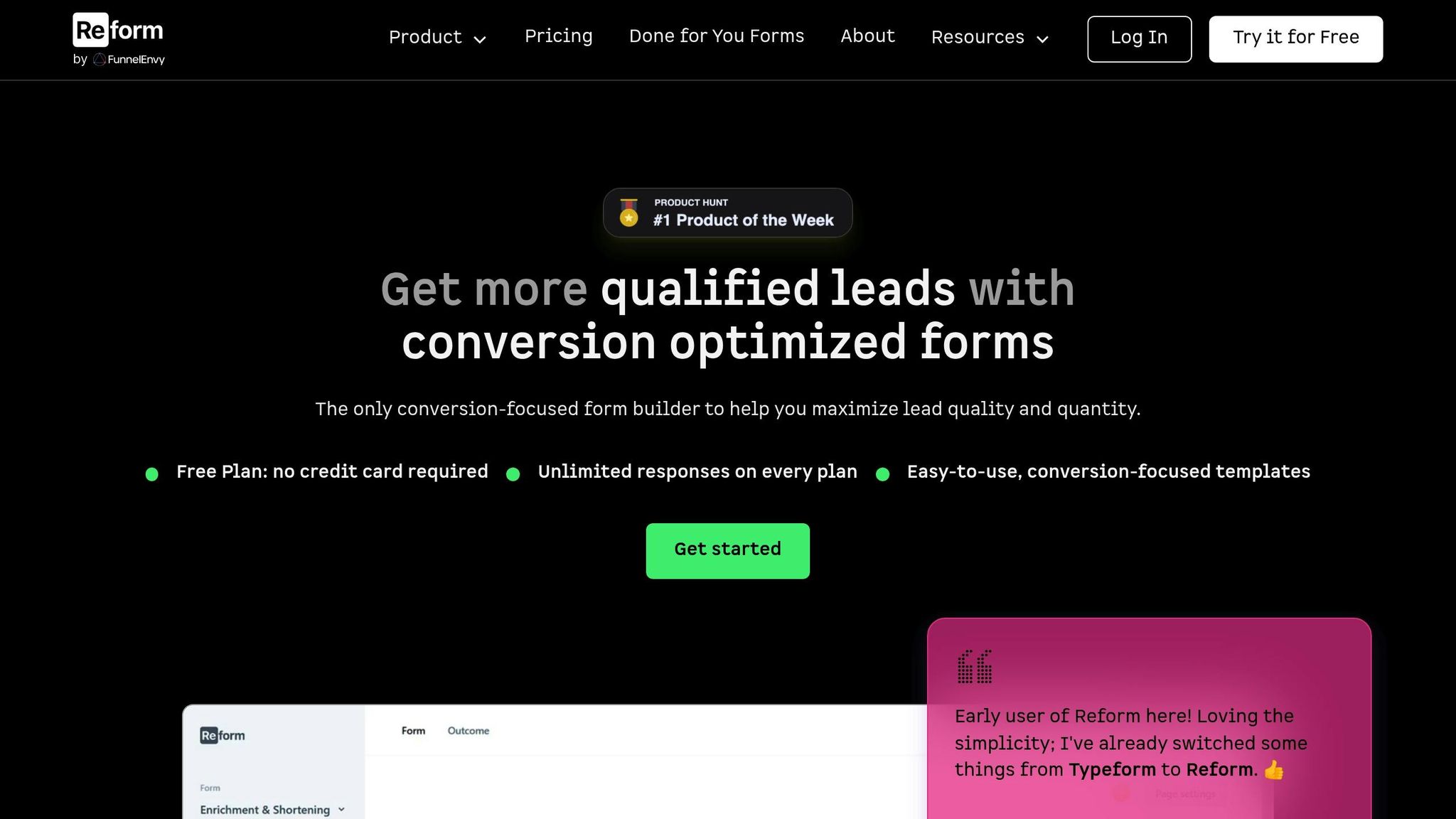Data-Driven Attribution vs Rule-Based: Which Fits Your Strategy?

Which attribution model is right for your business? It depends on your goals, resources, and the complexity of your marketing campaigns. Rule-based attribution is simple to implement and works well for straightforward customer journeys. Data-driven attribution, on the other hand, uses machine learning to analyze customer behavior and is better suited for multi-channel campaigns but requires more data, expertise, and budget.
Key Takeaways:
- Rule-Based Attribution: Uses fixed formulas like first-touch or last-touch to assign credit. It's easy to set up, low-cost, and ideal for smaller teams or simple campaigns.
- Data-Driven Attribution: Leverages algorithms to analyze customer interactions and assign credit based on actual influence. Offers greater accuracy but requires significant data, technical expertise, and investment.
Quick Comparison:
| Feature | Rule-Based Attribution | Data-Driven Attribution |
|---|---|---|
| Setup Complexity | Low | High |
| Credit Assignment | Fixed (e.g., first/last touch) | Based on behavior analysis |
| Data Requirements | Minimal | High |
| Cost | Low | High |
| Ideal Use Case | Simple campaigns | Complex, multi-channel campaigns |
For small businesses, start with rule-based models. Larger enterprises with complex campaigns can benefit from data-driven models, potentially boosting conversions by 6%. Choose the model that aligns with your current capabilities and marketing goals.
Google Ads Attribution: Last Click vs. Data-Driven Explained

Rule-Based Attribution Models: Simple and Direct Control
Rule-based attribution models rely on predefined formulas to assign credit for conversions. They provide a straightforward approach to assessing marketing performance.
What Are Rule-Based Attribution Models?
These models follow fixed rules to allocate credit for conversions. Common examples include:
- First-Touch Attribution: Assigns 100% credit to the first interaction with a customer.
- Last-Touch Attribution: Credits the final interaction before conversion.
- Linear Attribution: Distributes credit equally across all touchpoints.
- Time Decay Attribution: Gives more weight to interactions that occur closer to the conversion.
Additionally, Custom Attribution allows marketers to define their own rules, assigning credit based on their assessment of each touchpoint's role. While these models lack subtlety, their simplicity makes them appealing for teams seeking clarity.
Benefits of Rule-Based Attribution
One of the biggest advantages of rule-based attribution is its simplicity. These models don’t require advanced tools or specialized skills, making them accessible to teams of all sizes. Many marketing platforms include them as default options, allowing businesses to start tracking attribution with minimal effort.
For smaller businesses, these models are a cost-effective solution. They don’t demand significant investments in technology or dedicated analysts, making them an attractive option for teams with limited resources.
Another key benefit is transparency. Explaining how credit is assigned - whether to the first touchpoint, last touchpoint, or evenly across all interactions - is straightforward. This clarity fosters quick decision-making and ensures that stakeholders understand how performance is being evaluated.
In cases where customer journeys are relatively simple, with only a few interactions leading to conversion, rule-based models often deliver adequate insights without unnecessary complexity.
Drawbacks of Rule-Based Attribution
Despite their simplicity, rule-based models have notable limitations. Their rigid structure makes them less effective in capturing the complexities of modern, multi-channel marketing environments. For example, a first-touch model always credits the initial interaction, even if it had minimal influence on the final conversion. Similarly, a last-touch model ignores earlier touchpoints that may have played a critical role.
This rigidity can lead to skewed insights, especially in dynamic customer journeys. As marketing strategies evolve and customer behaviors shift, rule-based models remain static, failing to adapt. This can result in misallocated budgets and missed opportunities to optimize campaigns.
Another drawback is their inability to identify subtle patterns in customer behavior. They don’t account for how different touchpoints might work together to drive conversions, leaving gaps in understanding which combinations are most effective. As businesses adopt more complex and data-driven marketing strategies, these limitations can become increasingly problematic.
While rule-based models are a practical starting point for many teams, their shortcomings highlight the need for more flexible, data-driven approaches. These advanced models, which we’ll explore next, offer deeper insights and greater adaptability.
Data-Driven Attribution Models: Precision Through Machine Learning
Data-driven attribution takes marketing analysis to the next level by moving beyond the rigid formulas of rule-based models. Instead, it leverages machine learning to study real customer behavior and accurately assign credit to touchpoints based on their actual influence on conversions.
How Data-Driven Attribution Works
At its core, data-driven attribution relies on advanced algorithms - like Markov chains, Shapley values, and neural networks - to sift through extensive datasets. These tools analyze customer interactions to pinpoint which touchpoints play the most critical roles in driving conversions. What makes this approach stand out is its dynamic nature. As new data rolls in, the system continuously updates, adjusting attribution weights to reflect seasonal trends, shifts in campaigns, or changes in consumer behavior. Even better, these models tailor themselves to your business by learning the specific habits of your customers, the nuances of your industry, and the unique blend of your marketing efforts.
Benefits of Data-Driven Attribution
One of the biggest advantages of data-driven attribution is its ability to deliver more accurate insights, which can lead to up to a 6% increase in conversions. This accuracy comes from uncovering the true impact of each marketing effort. For instance, it might reveal that while social media interactions don’t directly lead to purchases, they amplify the success of email campaigns. These insights are invaluable for fine-tuning budgets, ensuring that your marketing dollars go to the channels that deliver the best results. Plus, the system’s real-time adaptability means it keeps pace with market changes and new campaigns, automatically recalibrating to stay effective.
Challenges of Data-Driven Attribution
Despite its advantages, data-driven attribution isn’t without its hurdles. The biggest challenge is its appetite for data - these models need a large volume of high-quality interactions to work effectively. Smaller businesses or those with limited online activity may struggle to meet this requirement. On top of that, implementing these systems demands expertise in advanced analytics, often requiring skilled professionals to manage the setup and ongoing operations. The work doesn’t stop there; maintaining and validating the models, as well as interpreting their findings, also requires continuous effort. And let’s not forget the financial investment - robust analytics tools and infrastructure don’t come cheap.
For companies with strong data systems and the resources to support complex analytics, data-driven attribution offers an unparalleled way to understand customer behavior. However, the costs and expertise involved mean it’s not the best fit for every business. These considerations pave the way for a closer comparison with rule-based models to determine which approach aligns better with your strategy.
sbb-itb-5f36581
Data-Driven vs Rule-Based Attribution: Side-by-Side Comparison
Let’s break down how these two attribution models stack up when it comes to marketing impact and budget allocation.
Comparison Table: Data-Driven vs Rule-Based Attribution
| Feature | Rule-Based Attribution | Data-Driven Attribution |
|---|---|---|
| Setup Complexity | Simple | Complex |
| Customization | Fixed, not tailored to specific businesses | Fully customized to business data |
| Credit Assignment | Based on touchpoint position | Driven by detailed behavior analysis |
| Adaptability | Static | Dynamic, evolves with new data |
| Data Requirements | Minimal | Requires large, high-quality datasets |
| Cost | Low | High (setup and maintenance) |
| Accuracy | May overlook subtle patterns | Tracks the full customer journey |
| Analysis Scope | Predefined touchpoints | All touchpoints and interactions |
| Ideal Use Case | Simple, low-budget campaigns | Complex, multi-channel campaigns |
This comparison highlights why each approach fits different marketing needs. Despite the advantages of data-driven attribution, many marketers still rely on traditional rule-based methods.
How Each Model Affects Marketing Strategy
The choice between rule-based and data-driven attribution has a direct impact on how you allocate budgets and craft campaigns. Rule-based models are appealing for their simplicity, while data-driven models stand out for their precision.
With rule-based attribution, decisions are often based on oversimplified metrics. Take last-click attribution as an example: it might lead you to funnel most of your budget into search ads or retargeting campaigns, ignoring other channels like social media or email newsletters that played a key role earlier in the customer journey.
On the other hand, data-driven attribution provides a clearer picture of how all touchpoints contribute to conversions. For instance, it might reveal that Instagram ads, while not directly driving sales, significantly amplify the effectiveness of your email campaigns. Armed with this insight, you can balance your spending across channels rather than cutting budgets based on incomplete data.
The financial benefits are clear. Companies that shift from rule-based to data-driven attribution often report a 6% increase in conversions. This boost comes from accurately identifying which touchpoints have the most influence on customer decisions, enabling smarter investment across the marketing funnel.
For small businesses with straightforward customer journeys, rule-based models can be sufficient. However, larger enterprises running complex, multi-channel campaigns stand to gain much more from data-driven attribution. These businesses typically deal with customers who engage with a mix of touchpoints - social media, email, paid ads, content marketing, and even direct mail - before making a purchase. Rule-based models simply can’t capture the nuanced relationships between these interactions.
The choice of model also impacts your team’s workflow. Rule-based attribution offers quick, easy-to-understand metrics that allow for fast decision-making. In contrast, data-driven attribution demands more analytical expertise but rewards you with deeper insights. These insights can uncover overlooked opportunities within your marketing efforts.
When your campaigns involve multiple channels and longer sales cycles, the weaknesses of rule-based models become more obvious. They often undervalue touchpoints that guide prospects through the awareness and consideration stages, focusing instead on bottom-funnel activities that capture demand already in play, rather than creating new opportunities.
How to Choose the Right Attribution Model for Your Business
Picking the right attribution model is a critical step that should align with your team’s skills, the data you have, and the complexity of your campaigns. The wrong choice could mean wasted budgets and missed opportunities, but the right one? It might boost conversions by 6%.
Key Factors When Choosing an Attribution Model
The decision-making process depends on several factors that can directly impact your success:
- Team size and expertise: If you’re working with a small team that doesn’t have dedicated analysts, rule-based models are a great starting point. They’re straightforward and don’t require extensive setup. Larger teams with access to data science resources, however, can dive into more advanced data-driven models for deeper insights.
- Data availability: A data-driven attribution model requires a substantial dataset, including details like timestamps, channels, and conversion events. If your data is limited, rule-based models are often the better choice.
- Customer journey complexity: For simple, single-channel customer journeys, rule-based models work well. But if your customer interactions span multiple channels and touchpoints, a data-driven model is better equipped to handle the complexity.
- Budget and infrastructure: Advanced models like data-driven attribution often require investments in analytics tools and training for your team. If you’re on a tighter budget, rule-based models are more accessible and cost-effective.
- Organizational goals: Your goals should guide your choice. If you need quick insights for immediate tweaks to your campaigns, a rule-based model works well. For long-term optimization, advanced analysis from a data-driven model is more suitable.
- Data privacy requirements: In the U.S., regulations like CCPA can complicate the use of data-driven models because they often require extensive data collection. Rule-based models might be easier to manage in these cases.
A smart approach is to start with rule-based models, which are easier to implement, and transition to data-driven models as your team grows more experienced and your data capabilities improve. This gradual shift avoids overwhelming your team while setting you up for long-term success.
How Reform Supports Attribution and Lead Optimization

Choosing the right tool for attribution is just as important as selecting the right model. Reform simplifies this process by enhancing data collection and improving lead quality, making it a valuable partner for businesses.
Here’s how Reform helps:
- Real-time analytics: Reform delivers instant feedback on how users interact with your forms. This allows you to quickly refine your lead capture process, ensuring better data for both rule-based and data-driven attribution models.
- CRM and marketing automation integrations: The platform integrates seamlessly with your existing systems, ensuring that all lead data flows smoothly into central platforms. Features like custom mapping and duplicate handling maintain data accuracy, which is critical for effective cross-channel attribution.
- Lead enrichment: Reform automatically gathers additional details about your prospects, giving you richer profiles that provide deeper insights into customer behavior and preferences.
- Conditional routing and lead qualification: By segmenting leads based on specific rules, you can assign different values to leads depending on their quality and likelihood to convert. This supports more precise attribution strategies.
- A/B testing: With built-in testing tools, you can experiment with different form designs and workflows to optimize conversion paths and identify the most impactful touchpoints in your customer journey.
- Abandoned submission data: Reform tracks where users drop off, giving you valuable insights into engagement levels and potential friction points. This data can be especially useful for fine-tuning more advanced attribution models.
- Webhooks and APIs: Reform’s connectivity options let you integrate with internal tools and platforms, automating data collection and ensuring that all relevant information is available for analysis.
Reform’s methods have been tested extensively, and the results speak for themselves: a 215% increase in qualified leads for B2B and SaaS companies. This boost in lead quality not only improves your campaigns but also enhances the accuracy of your attribution models, regardless of which one you choose.
With its no-code setup, Reform makes it easier for teams to scale their attribution efforts as they grow, ensuring you’re always ready to handle more complex strategies down the road.
Conclusion: Match Your Attribution Model to Your Marketing Goals
When it comes to attribution, the goal isn't to chase a "perfect" model - it’s about finding the best fit for your business needs. Interestingly, only 11% of marketers use data-driven attribution, while 35% still rely on rule-based methods.
Your choice should reflect your resources, the complexity of your customer journey, and your overall business objectives. For smaller teams or straightforward campaigns, rule-based attribution offers clarity and is easy to implement. On the other hand, if you’re managing intricate, multi-channel campaigns with large datasets, data-driven models can deliver measurable benefits - like a 6% increase in conversions, which can make the investment worthwhile.
Attribution doesn’t have to be static. Start with a simple model and scale up as your data and expertise expand. Many businesses begin with rule-based models to gain foundational insights, then transition to data-driven approaches as their capabilities grow. This gradual evolution ensures you can build confidence and expertise without overextending your resources.
To make the most of your attribution strategy, you need reliable data. That’s where Reform comes in. Whether you’re tracking first-touch interactions or feeding detailed customer journey data into machine learning tools, Reform’s real-time analytics, lead enrichment, and seamless integrations provide the solid foundation your attribution model needs.
Choose the model that aligns with your goals, and don’t stop there. Implement, measure, and refine your strategy to enhance your marketing ROI and make smarter budget decisions as your campaigns grow more sophisticated.
FAQs
How can a growing small business switch from rule-based to data-driven attribution?
Transitioning from a rule-based to a data-driven attribution model can transform how small businesses approach their marketing efforts. The first step is to ensure you’re collecting enough data to support this shift. This means tracking customer interactions across various touchpoints, from ads to social media, emails, and beyond.
Once you have the data, the next move is to invest in tools or platforms that can analyze it effectively. These tools will help you understand the role each channel plays in driving conversions. As your business grows, it might also be worth training your team or bringing in specialists who can dive deeper into the insights provided by the data. A data-driven attribution model can reveal how each marketing channel contributes to your success, giving you the clarity to allocate budgets wisely and refine your overall strategy.
What key metrics should you focus on for a successful data-driven attribution model?
To build a strong data-driven attribution model, it's essential to zero in on metrics that shed light on both customer behavior and campaign effectiveness. Here are the key metrics to consider:
- Conversion data: Keep track of specific actions like purchases, sign-ups, or downloads. These actions reveal what drives meaningful results for your business.
- Customer journey insights: Dive into touchpoints such as clicks, impressions, and interactions across different channels. This helps map out how customers engage with your brand.
- Revenue impact: Evaluate the dollar value generated by each channel or campaign to understand their financial contribution.
By analyzing these metrics together, you can uncover trends and allocate your marketing budget more strategically to boost your return on investment (ROI).
How does data-driven attribution adapt to shifts in customer behavior or marketing strategies?
Data-driven attribution leverages machine learning to evaluate the impact of various marketing touchpoints on conversions. Unlike traditional rule-based models, it evolves constantly by analyzing real-time data. This means it can quickly adapt to shifts in customer behavior or updates to marketing strategies, making it a powerful tool for fast-paced and ever-changing marketing landscapes.
Related Blog Posts
Get new content delivered straight to your inbox

The Response
Updates on the Reform platform, insights on optimizing conversion rates, and tips to craft forms that convert.
Drive real results with form optimizations
Tested across hundreds of experiments, our strategies deliver a 215% lift in qualified leads for B2B and SaaS companies.





